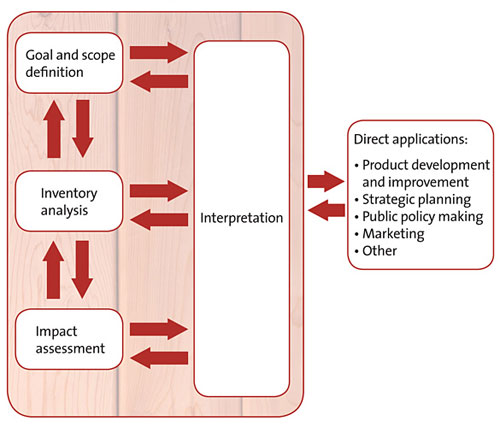Getting to Green: Life Cycle Analysis plus Forest Certification Give Western Redcedar High Marks in Sustainability
Life Cycle Analysis:Â The Basics
Getting to green can be perplexing, especially as manufacturers may only promote certain attributes of their products, keeping mum on their more questionable environmental impacts. Advertising may tout the fact that a product may be biodegradable or contain recycled content, for example, while its high degree of embodied energy or emissions goes unmentioned. In view of the challenges involved in getting to the truth about a product's true environmental picture, many companies have enlisted the support of the Life Cycle Analysis (LCA) to back up their sustainability claims. Also known as life cycle assessment, ecobalance, and cradle-to-grave analysis, the LCA is a decision making tool. It acknowledges that all phases of a product's life, from cradle to grave, have an impact on the environment and these impacts can be quantified and compared. The LCA assesses those impacts from the time materials are extracted through manufacture, transportation, storage, use, recovery, reuse and disposal.
The1970s global modeling studies and energy audits that sought to evaluate resource cost and environmental implications of different patterns of actions were the forerunners of life cycle assessments and analysis. The LCA approach really took shape in the 1980s, though for many years was mainly popular in Europe. Now the LCA is gaining traction in North America as companies look to give teeth to their environmental claims or pinpoint where in the cradle-to-grave process their environmental liabilities are most prevalent. In many industries, LCAs are becoming crucial to the support of ecolabelling, as awarding authorities must rely on a scientific method of evaluating the manufacturing processes involved, the energy consumption in manufacture and use, and the amount and type of waste generated.
Generally speaking, there are four stages of an LCA:
Goal and Scope Definition. Goals, system boundaries and intended uses are established.
Life Cycle Inventory. A data-based quantification of energy and raw material requirements, air emissions, waterborne effluents, solid waste and other environmental releases through the life of a product or process.
Life Cycle Impact Assessment. An evaluation of the effects of the environmental information collected in the inventory. A full impact assessment addresses ecological and human health, as well as the range of social, cultural and economic effects.
Life Cycle Improvement Analysis. Identification of areas where environmental impacts can be reduced or mitigated within the life cycle of the product or processes.
| Life Cycle Assessment Framework |
 |









